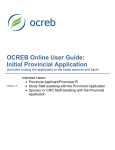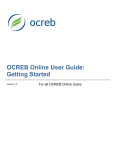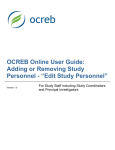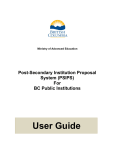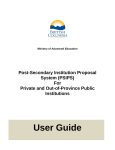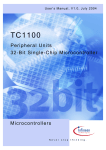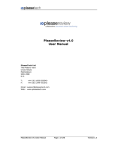Download OCREB Online User Guide
Transcript
OCREB Online User Guide: Complete Guide for Applicants Version 1.0 For Study Staff including Study Coordinators and Principal Investigators Table of Contents 1. 2. 3. About OCREB Online .................................................................................................................................. 4 1.1. Intended Audience ............................................................................................................................... 4 1.2. Accessing the System ......................................................................................................................... 4 1.3. Technical Details .................................................................................................................................. 4 1.4. Sandbox (Practice Area) ..................................................................................................................... 4 1.5. O2 Help.................................................................................................................................................. 4 Getting Started.............................................................................................................................................. 5 2.1. O2 Home Page ..................................................................................................................................... 5 2.2. Logging In.............................................................................................................................................. 5 2.3. Registration ........................................................................................................................................... 5 2.4. User Profile – Contact and Password Information.......................................................................... 6 2.5. Access Levels/Roles............................................................................................................................ 7 2.6. Researcher Profile ............................................................................................................................... 8 Navigating OCREB Online.......................................................................................................................... 9 3.1. “My Home” Page .................................................................................................................................. 9 3.1.1. My Home Page Study Tabs...................................................................................................... 10 3.1.2. Finding Your Submissions ........................................................................................................ 11 3.2. Navigation Bar .................................................................................................................................... 11 3.3. Studies Page....................................................................................................................................... 12 3.3.1. 3.4. Centres Page ...................................................................................................................................... 13 3.4.1. 4. Amendments, Renewals and Reportable Events Pages ..................................................... 12 Centre Profile .............................................................................................................................. 13 Initial (New) Provincial Study.................................................................................................................... 14 4.1. Presubmission .................................................................................................................................... 14 4.1.1. Uploading Documents ............................................................................................................... 16 4.1.2. Study Workspace ....................................................................................................................... 18 4.1.3. Finalizing the Provincial Application........................................................................................ 19 4.2. Submission (PI Only) ......................................................................................................................... 20 4.3. Contingencies ..................................................................................................................................... 21 Ontario Cancer Research Ethics Board OCREB Online User Guide for Study Staff (Complete) Version 1.0 (2011-Feb-21) Page 2 of 43 5. 4.4. Tracking the Progress of the Application........................................................................................ 22 4.5. Pending PI Response........................................................................................................................ 23 4.5.1. Accessing the OCREB Review Letter..................................................................................... 23 4.5.2. Accessing the OCREB Recommended Changes to the Consent Form(s)....................... 23 4.5.3. Preparing the PI Response ...................................................................................................... 24 4.5.4. Submitting the PI Response ..................................................................................................... 25 Post-Approval Activities............................................................................................................................. 26 5.1. Initial Centre Application – New Centre Study .............................................................................. 26 5.1.1. Consent Principles ..................................................................................................................... 27 5.1.2. Finalizing the Centre Application ............................................................................................. 27 5.1.3. Submitting the Centre Application – Principal Investigator Only ........................................ 28 5.1.4. Department Approvals/Signatories.......................................................................................... 29 5.1.5. Contingencies ............................................................................................................................. 30 5.1.6. Accessing Centre Approval Letters and Approved Documents.......................................... 31 5.1.7. Centre Application or Provincial Application – Where am I?............................................... 32 5.2. Amendments ....................................................................................................................................... 33 5.2.1. Opting Out of a Provincial Amendment .................................................................................. 34 5.2.2. Centre-Specific Amendments .................................................................................................. 34 5.2.3. Amendments Involving a Change in Provincial Applicant and/or Centre PI..................... 35 5.3. Reportable Events.............................................................................................................................. 37 5.4. Renewals ............................................................................................................................................. 37 5.5. Study Closure ..................................................................................................................................... 38 6. System Notifications .................................................................................................................................. 38 7. Issues & Support ........................................................................................................................................ 38 8. Application “States”.................................................................................................................................... 39 9. Tips ............................................................................................................................................................... 40 9.1. Formatting, Copying & Pasting .................................................................................................... 40 9.2. Working with Multiple Windows ................................................................................................... 40 9.3. Windows Computer Tips ............................................................................................................... 40 9.4. Reminders: ...................................................................................................................................... 40 9.5. Changing the Date Format: .......................................................................................................... 42 Ontario Cancer Research Ethics Board OCREB Online User Guide for Study Staff (Complete) Version 1.0 (2011-Feb-21) Page 3 of 43 1. About OCREB Online OCREB Online (O2) is a transparent, secure, web-based system designed to automate and streamline the preparation, submission and review processes for ethics applications submitted to OCREB by institutions in Ontario authorized to use OCREB. Ethics applications for new studies and post-approval applications such as amendments, renewals, study closures and reportable events (e.g., local SAEs, safety updates, DSMB reports, protocol deviations), are submitted via the online system by the principal investigator or by the designated study team member. Applications are prepared using “smart forms”, which dynamically show or hide questions depending on the applicability to the study. The system automatically prompts for missing information, thereby ensuring that submissions are complete before submission. 1.1. Intended Audience This guide is intended for applicants to OCREB, in particular, study coordinators and principal investigators (PIs). It also contains information for department approvers. The guide provides users with useful information on the overall OCREB Online system, as well as how to navigate the system and how to submit and track submissions to OCREB. The guide is structured so that if follows the most likely order of submissions: new provincial initial study application, initial centre applications, amendments, renewals, reportable events and study closures. 1.2. Accessing the System To access the live O2 system, go to https://ocrebonline.ca. Review the Terms and Conditions for restrictions on and authorized use of O2, and for privacy, security and confidentiality details. 1.3. Technical Details • • • • • 1.4. O2 is best viewed on Microsoft Internet Explorer (version 7 or higher recommended). O2 will also work on Mozilla Firefox, Apple’s Safari (Mac), and Google Chrome. Sun Java will be required for downloading files from O2, which can be obtained from www.java.com/en/. If you have firewall or downloading restrictions, you may need local IT assistance to download this onto your work computers. O2 uses pop-ups and multiple windows. You will need to allow pop-ups for the O2 website so that these windows are not blocked. The display of system-generated date fields is dependent upon the settings on the computer that you are accessing the system with as well as the browser you are using (see page 42). Sandbox (Practice Area) Users can familiarize themselves with O2 in the “Sandbox” at https://o2-staging.oicr.on.ca. The Sandbox is a practice environment where users can test-drive the system without using real data. Contact the O2 Help for a user name and password for the Sandbox. 1.5. O2 Help • • • Submit issues or questions via the Issues & Support page from within the O2 system; Email – [email protected]; or Phone - 647-260-7945 or toll-free: 1-866-678-6427 Ext 7945. Ontario Cancer Research Ethics Board OCREB Online User Guide for Study Staff (Complete) Version 1.0 (2011-Feb-21) Page 4 of 43 2. Getting Started 2.1. O2 Home Page On the O2 home page you will find the login link, as well as links to other OCREB information such as policies and procedures, templates, user guides and OCREB meeting dates and deadlines. 2.2. Logging In The O2 team will create an account for each authorized O2 user and provide a user name and password. If you already have your user name and password, select the Login link in the top right-hand corner of the screen to go to the login screen. The first time you login, you will be prompted to change your password. 2.3. Registration If you do not have a user name and password, you will need to register. To register, select the Registration link in the bottom left-hand corner of the OCREB home page, complete the registration form and select Register to submit. The OCREB office must have your access authorized (e.g., by your manager) before creating your account and providing you with a user name and temporary password. Ontario Cancer Research Ethics Board OCREB Online User Guide for Study Staff (Complete) Version 1.0 (2011-Feb-21) Page 5 of 43 2.4. User Profile – Contact and Password Information When you login the first time, you will be directed to your User Profile to verify your contact information. Select Apply to save any changes. To change your password at any time, select your name from the user menu bar. This will take you to your user profile. Select the Account tab to access the password area. Passwords must contain at least six (6) characters in an alphanumeric combination. Passwords must not be shared or stored in a visible and accessible location, i.e. written down. Passwords must NOT contain: • • • • any words that could be found in a dictionary; any words or references to the type of work being performed in relation to the system on which the password is being deployed; any identifying user information such as birthdays, spouse’s birthdays, anniversaries, children’s birthdays, pet names or other similar types of identifying information; three or more consecutive characters from your username. If you fail to successfully login after five (5) attempts, the system will lock you out and you will need to call O2 Help to have your password reset. Ontario Cancer Research Ethics Board OCREB Online User Guide for Study Staff (Complete) Version 1.0 (2011-Feb-21) Page 6 of 43 2.5. Access Levels/Roles Most O2 users will have only one O2 role (i.e., Study Staff). However, if you are a PI and a department approver, both roles will be added to your profile. Although all “Study Staff” share the same role name, your authorized activities (e.g., view only, make changes, submit) depend on the permissions set for your specific study staff role (e.g., PI, main study coordinator, co-investigator, other study staff). If you have more than one user role, switch between roles by selecting the appropriate role on My Home page. NB. The role that you select will determine the information that is displayed on your screen and the activities you are allowed to execute. Ontario Cancer Research Ethics Board OCREB Online User Guide for Study Staff (Complete) Version 1.0 (2011-Feb-21) Page 7 of 43 2.6. Researcher Profile The Researcher Profile link on My Home will take you to your researcher profile (if you are a PI) or to a list of profiles for all PIs that you are linked with (if you are a study coordinator). The Researcher Profile collects information similar to that in the OCREB New PI Form. First-time O2 users: Select Edit Researcher Profile, complete the fields and upload the PI’s most current CV. This can be done by a study coordinator linked to a PI or by the PI. A PI can add study coordinators to his/her profile, granting them permission to update the Researcher Profile, add the PI to new ethics applications, to create an ethics application, to add or remove study coordinators from individual studies, and to submit post-approval applications (e.g., amendments) on his/her behalf. The Researcher Profile link on My Home page links to the PI profiles. Select Edit Researcher Profile to make changes. Select Printer Version to view or print the full profile. Complete the profile fields and upload the PI’s most current CV. Select relevant study coordinators from a pop-up list to add to this PI’s profile. Press Finish to complete. Ontario Cancer Research Ethics Board OCREB Online User Guide for Study Staff (Complete) Version 1.0 (2011-Feb-21) Page 8 of 43 3. Navigating OCREB Online It is important to spend some time figuring out how to navigate this new system. O2 consists of a variety of pages and workspaces. The different pages help to organize and display information in a logical fashion and they act as gateways to specific study areas. Workspaces are unique areas that contain activity buttons and are where you work on your various ethics applications (e.g., on a new provincial study or on post provincial study approval activities such as amendments, centre applications, reportable events, renewals, etc). 3.1. “My Home” Page Except for the first time you login, every subsequent login will take you to your personal home page “My Home”. If you have more than one role in O2, this page will differ slightly for each user role. Selecting My Home in the upper right-hand corner of the screen will bring you back to this page if you get lost. My Home page contains: 1. A system navigation bar with links to various pages. This navigation bar is visible from any page or workspace in the system; 2. A user tool bar/menu, with links to your profile and your home page (“My Home”). (You can link to your personal profile to review or update it at any time by clicking on your name). This user tool bar/menu is visible from any page or workspace in the system; 3. My Roles, which allows you to toggle between user roles by selecting the applicable user role (if you have more than one role); 4. A activity button, which will open a new Provincial application to allow you to prepare to submit a new study. This button is available from most pages and workspaces; 5. My… submission tabs, which display items requiring action by you (“My Action Items”) and other tabs where you can monitor the progress of your studies and the different types of submissions related to your studies (details on page 9). My… submission tabs show only those studies and their related submissions that you are directly involved in; 6. Quick Links – for example, to OCREB templates. 2 1 3 4 6 Ontario Cancer Research Ethics Board OCREB Online User Guide for Study Staff (Complete) Version 1.0 (2011-Feb-21) 5 Page 9 of 43 3.1.1. My Home Page Study Tabs My Action Items – displays items requiring action by you. When you log in, this tab will show as your default view. Once you complete your action, the submission will move out of this area to the next step in the review process. My Studies – displays all studies that you are preparing to submit or have submitted. Other columns show attributes such as: current state, application type (provincial versus centre), review type, PI name and expiry date, etc. My Amendments – displays all your amendment applications regardless of the current state (i.e., even those you are working on “pre-submission”) My Renewals – displays a list of your renewal applications regardless of the current state. My Reportable Events – displays a list of all your reportable events, including the type of reportable event. Ontario Cancer Research Ethics Board OCREB Online User Guide for Study Staff (Complete) Version 1.0 (2011-Feb-21) Page 10 of 43 3.1.2. Finding Your Submissions Many views have a “Filter” feature to allow users to more easily find an item in a long list. For example, to find a study by sponsor protocol number, select My Studies tab, enter the exact protocol number in the Filter by “Name” field, and press Go. To find a PI, Filter by “First” or “Last” name, enter the name in the adjacent field and press Go. Press Clear to return to the full list. If you know the O2 system-generated project (“PRO”) number, filter by “ID” and use “%” in front of last 3 numbers of the PRO number to find the project. You can sort most columns in ascending or descending order. If you move your cursor over the column heading, it will change to a link if the column allows sorting. Select the column heading to sort. Select the column again to sort in the opposite direction. or or or , etc. (e.g., if you wish to display studies by the closest expiry date, sort by ascending “Expiration Date”): If there are more items than can be displayed on one page, a bar at the bottom of the page will show the total number of items in the entire list, as well as how many items are displayed on the current page ( 3.2. ). To go to the next page, select . Select to go to the last page. Navigation Bar The navigation bar is visible no matter where you are in the system, with links to: 1. O2 Home – takes you to the OCREB Online home page without logging you out; 2. Studies – links to a page listing all provincial and centre studies that you are associated with; 3. Centres – links to your centre profile page that includes a list of staff at your institution in the system, a list of all of the studies your centre is participating in, and other centre-specific items; 4. Researcher Profile - links to your researcher profile (if you are a PI), or to a list of Profiles for all PIs that you are linked with (if you are a study coordinator). See page 7 for details; 5. Issues & Support – links to a page where you can submit questions or issues to the OCREB Online team and access User Guides and Frequently Asked Questions (FAQs). 1 2 3 Ontario Cancer Research Ethics Board OCREB Online User Guide for Study Staff (Complete) Version 1.0 (2011-Feb-21) 4 5 Page 11 of 43 3.3. Studies Page The Studies page is where you access all studies you are involved in: Provincial (top) or Centre (bottom). This includes provincial applications where you are NOT the provincial applicant, but your centre is participating or listed as potentially participating, even if you have not yet submitted your centre application. The various tabs link to Provincial and to Centre studies by their current state (i.e., “In Progress”, “Approved”, “Closed”), or to a list of “All Studies” regardless of their current state. On the left-hand side, you will see a menu of Other Submission Types from where you can access all postapproval provincial and centre submissions (amendments, renewals, and reportable events) related to all studies. Think of these as subfolders of the study. 3.3.1. Amendments, Renewals and Reportable Events Pages Amendments page – displays a list of all provincial and centre amendment applications for all studies you are involved in. Tip: look for the crumb trail or the page title to confirm your location. Reportable Events page – displays a list of all provincial and centre reportable event submissions (e.g., local SAE, protocol deviation, safety update, DSMB report) for all studies you are involved in. Ontario Cancer Research Ethics Board OCREB Online User Guide for Study Staff (Complete) Version 1.0 (2011-Feb-21) Page 12 of 43 3.4. Centres Page Selecting Centres in the navigation bar will take you to a link to your Centre profile. Select the link to open the profile. Only users at your centre and in the OCREB office will be able to view your Centre Profile. 3.4.1. Centre Profile The centre profile page allows you to view information pertaining to your centre including, a List of Staff at your centre who are registered in the O2 system, a place to store any relevant Centre Policies if you so choose, a list of OCREB Approved Consent Form Changes, a list of all Studies running at your centre, and a list of all provincial studies created by your centre (Provincial Studies Created By). The History tab will display the history of all changes made to your centre profile, the date the changes were made and by whom. Select the appropriate tab to view the relevant information. Are you ready to dive in and prepare a provincial submission? Ontario Cancer Research Ethics Board OCREB Online User Guide for Study Staff (Complete) Version 1.0 (2011-Feb-21) Page 13 of 43 4. Initial (New) Provincial Study 4.1. Presubmission Before you begin, prepare your submission documents (protocol, IB and/or PM, study budget, consent forms, NOL if available, other patient materials, etc). You will be directed to upload these documents at appropriate places in the application. Clearly name and organize them in an easily-accessible area somewhere on your computer or local network. To start a new provincial application, select New Provincial Study. This is accessible from a variety of places, including Researcher Profile, Studies page and My Home page. You must complete and Save (1) the first page of the application form before the study record is created. 1 2 When you are finished with the current page, select Continue (2), to move to the next page. Questions marked with a red asterisk (*) are mandatory. You will not be allowed to continue to the next page unless these questions have been answered. However, at any point after the study is created, you can Exit and come back to work on it later by selecting from the study workspace. Ontario Cancer Research Ethics Board OCREB Online User Guide for Study Staff (Complete) Version 1.0 (2011-Feb-21) Page 14 of 43 Once you have created your study, new menu options will appear, and the top right-hand corner of the screen will now display a unique identifier assigned to your application. Menu options: 1. Save – saves your work and keeps you on the same page. If any mandatory questions on that page are not yet answered, you will not be able to save; however, you can Exit; 2. Exit – takes you out of the application to the study workspace; 3. Hide/Show Errors – will display a list of mandatory questions that have not been answered; 4. Jump To – is a drop down list that allows you to “jump” directly to other sections of the form; 5. Back or Continue – will take you to the previous page or to the next page of the application. 1 2 3 4 Under Study Locations & Other Reviews, select the centres/PIs that plan to participate in the study (obtain this information from the study sponsor). You must add your own centre as a study location in order to be able to submit your centre application. If you start typing the last name, first name or organization in the fields in any application form that ask you to Select a person, choices with similar names will appear for you to select from. You also may Select and choose from a full drop-down list. Select the main study coordinator who will receive all notifications related to the provincial study. Add any other Study Staff members requiring access to the provincial study, including the ability to submit amendments, renewals or reportable events. These additional staff will not receive the notifications. Ontario Cancer Research Ethics Board OCREB Online User Guide for Study Staff (Complete) Version 1.0 (2011-Feb-21) Page 15 of 43 4.1.1. Uploading Documents At various points in the application, you will be prompted to upload relevant documents. Uploading a document is a two-step process. Selecting Add will open up an Edit/Add Document window. Enter the version date of the document and select Add again to upload. This will open up another window. Enter the title of the document and select Browse to locate the document on your computer. Select OK to upload the document to the application. Select OK and Add Another to upload other documents, or select OK until you return to the application form. If the document is password protected, you will need to select Show Advanced Options and write the password in the “Description” field. You should now see the uploaded document(s) and the version date(s). Select Update to correct the version date. If you have uploaded the wrong document, select Delete and then Add to upload the correct document. If you do not enter a document name in the Title field, the “File” name will default to the name you gave to the original document. This means that if you have already clearly named your documents, you can skip entering the Title field in the upload procedure. Ontario Cancer Research Ethics Board OCREB Online User Guide for Study Staff (Complete) Version 1.0 (2011-Feb-21) Page 16 of 43 The application forms are designed to show or hide questions as they apply to your study (“SmartForms”). Using the Jump To menu to navigate from page to page as you work through the application instead of Continue will override this feature. However, using the Jump To menu is a very good way to come back to a page that your were previously working on. We strongly recommend that you use the Continue button to move to the next page when you are filling in the application. Because each type of submission (e.g., initial provincial, initial centre, amendment, reportable event) is issued a different system-generated number, a standard OCREB number will be assigned to the overall project file. The format will remain the same as the current numbering system – i.e., the first two numbers of the current year followed by a 3digit number (e.g., 11-001) Until this process is automated, please call the OCREB office (416-673-6649) for your OCREB number before completing your application. Enter the assigned OCREB number in the application in the relevant question. A column displaying the OCREB number will be added to every submission listing view. Ontario Cancer Research Ethics Board OCREB Online User Guide for Study Staff (Complete) Version 1.0 (2011-Feb-21) Page 17 of 43 4.1.2. Study Workspace When you Finish or anytime you Exit the application, you end up in the Study Workspace: 1. State – displays where your application is in the ethics review process. The state name will change as the application is routed through the review steps. You can monitor the progress of your study by looking at its current state; 2. Edit Application takes you back to the application to make edits any time prior to submission; 3. View Smartform Progress displays questions in the application as complete or incomplete; 4. My Activities – shows all activities that you can execute in this state (e.g., “Pre Submission”). Activities will change as the state changes with the various steps of the review process; • “Submit Study” is only available to the PI for initial provincial and initial centre applications; • “Withdraw” – removes the study from REB review anytime after it has been submitted; • “Edit the Email List” to add others (in addition to the PI and main study contact) who should receive notices; • “Edit Guest List” to give others read access to the study; • “Send Email to PI” sends an email from the system to the PI’s regular email address; • “Send Email to REB Staff” sends an email to the REB office. 5. Project Properties tab – displays information about the study. This information auto populates from the application form and upon completion of other system activities; Centres tab – shows a list of potential centres participating in the study 6. History tab – displays an ongoing list of study activities (some of the REB activities will not be displayed to study staff for confidentiality reasons); 7. Attachments tab – in one location, provides a listing of and access to all documents that were uploaded to the application. 1 5 2 3 4 6 7 Ontario Cancer Research Ethics Board OCREB Online User Guide for Study Staff (Complete) Version 1.0 (2011-Feb-21) Page 18 of 43 4.1.3. Finalizing the Provincial Application The study will remain in My Action Items until it is submitted. Select to open the application and make edits at any time prior to submission. Once you are back in the application, select to continue section by section, or use the menu to go to a specific section or sections. These two options can be found at the top and the bottom of the application. As you Continue from page to page, an error message will appear if any of the mandatory questions on that page have not been answered. REMEMBER that using the Jump To menu will override the SmartForm feature that shows or hides questions as applicable to your study. For example if the collection of biological specimens is included in your study, selecting “Biological Specimens” in the “Research and Methods” section of the application will result in the appearance of questions relating specifically to biological specimens. If you are collecting biological specimens in your study and you don’t see the related questions, go back to ensure that you made the appropriate selections in the “Research and Methods” section. Once the application is finished, double-check that it is complete before submitting it (if you are the PI), or before contacting the PI to submit (if you are the study coordinator). Selecting will open up a Progress window showing whether the sections are complete or incomplete. If a section is “incomplete” it means that at least one of the mandatory questions was not answered. Select the item from the “Section” column to go directly to that section. Once you have determined that the application is complete, if you are the study coordinator you can inform the PI from within OCREB Online by pressing the activity button, you can send an email outside the O2 system using your institutions email system (e.g., Outlook), or you can simply call the PI or tell the PI in person that the study is ready for him/her to submit. Ontario Cancer Research Ethics Board OCREB Online User Guide for Study Staff (Complete) Version 1.0 (2011-Feb-21) Page 19 of 43 4.2. Submission (PI Only) Only the PI has the authority to submit an initial provincial application. The PI must login and locate the study in My Action Items on his/her home page and select the study “Name” to open up the provincial study workspace. The PI can review the application by viewing the “Printer Version” or review and edit the application by selecting . When ready, the PI selects . If the application is incomplete, an error message will list all questions that are incomplete. Selecting the link in the Jump To column will take the PI directly to the application page in question. The PI will not be terribly happy if this error message pops up at this stage…. If application is complete, the Provincial Applicant/PI Agreement window will appear. Check off the box in the bottom left-hand corner before selecting OK to submit the study. This serves as the official Provincial Applicant/PI signature. Once submitted, the study moves out of My Action Items and Study Staff can no longer make any changes. The principal investigator must login to officially sign-off on the initial provincial application. This activity cannot be delegated; doing so is equivalent to forging a signature. Ontario Cancer Research Ethics Board OCREB Online User Guide for Study Staff (Complete) Version 1.0 (2011-Feb-21) Page 20 of 43 4.3. Contingencies Once your study has been submitted, the Intake Coordinator at OCREB will review your application and send it back to you to edit or assign it to an REB Coordinator, as applicable. The REB Coordinator will review the application, set contingencies as required, and either assign it to a meeting, assign it to an expedited reviewer or send the application back to you to edit as applicable. If the application is sent back to the Study Staff, you and the PI will receive an email with a link to the study. The study will be located under the My Action Items tab, which means it now requires action by you. At this point, it is opened up for you to edit. A contingency is an item that was not included at the time of initial submission, but must be submitted before approval can be issued. The Health Canada authorization (e.g., NOL, ITA, NHP), the study budget and the Clinical Trial Registration number are all possible contingencies for provincial initial applications. To view any contingencies, from the Study workspace select the Attachments tab and scroll down to Attached Documents - Other. Note that the Date Completed column is blank indicating that these items must be received by OCREB before approval can be issued. To submit these outstanding items, upload them to the application if they are available at the time of submitting the revised application with your PI response. Alternatively, you can attach and send them in a regular email to the REB Coordinator “Owner” of your study. If the items are sent by email, the REB Coordinator will upload them to the contingency area and change the contingency to “completed”. This now will allow the approval to be issued. Because the REB office cannot modify your application, this is where you find any contingency documents it they are received separately from your application. Ontario Cancer Research Ethics Board OCREB Online User Guide for Study Staff (Complete) Version 1.0 (2011-Feb-21) Page 21 of 43 4.4. Tracking the Progress of the Application A unique feature of the OCREB Online system is that you can easily track the progress of your application through the entire ethics review process. If you look at the top left-hand side of the Study workspace, highlighted in yellow is the current “State” your application is in. For example, before you submit the study, the state of your application is called “Pre-Submission”. After you submit the study it will change to “REB Administrative Review”, and to “REB Staff Review” once assigned to an REB Coordinator. Upon submission, the State changes from … to . You can track the progress of your application by viewing the State column on My Home page: or in the State column on the Studies page…. Ontario Cancer Research Ethics Board OCREB Online User Guide for Study Staff (Complete) Version 1.0 (2011-Feb-21) Page 22 of 43 4.5. Pending PI Response Once the initial application has undergone REB review (typically at a full Board meeting), the REB will issue a review letter with any questions, requests for clarifications, recommendations, or concerns. Once the review letter is issued, the state automatically changes to PI Response Pending. 4.5.1. Accessing the OCREB Review Letter When the REB review letter is issued, the PI and Study Coordinator both will receive an automatic email notice with a direct link to the study workspace. The study also shows up in the My Action Items tab with any other items requiring action by you. Select the study from the “Name” column to open the study workspace. The application is now open to the Study Staff to edit in response to the OCREB review letter. Find the review letter under the Letters tab, and select View Correspondence Letter to open the letter. To download a copy, right click on View Correspondence Letter. 4.5.2. Accessing the OCREB Recommended Changes to the Consent Form(s) The REB recommended consent changes will be tracked directly in the consent forms. Download copies to your computer to review and accept or reject the changes as agreed with the PI and sponsor. Change the version date and be prepared to upload the revised consents to the edited application to submit with the PI response. The review letter will contain a link to the consent forms containing the REB recommended changes. The consent forms with the REB recommended changes also can be accessed in the same area as Contingencies: from the Study workspace select the Attachments tab and scroll down to Attached Documents – Other. Ontario Cancer Research Ethics Board OCREB Online User Guide for Study Staff (Complete) Version 1.0 (2011-Feb-21) Page 23 of 43 4.5.3. Preparing the PI Response To prepare the PI response, create a response letter on your local letterhead. We recomment that you copy and paste the REB questions into the response letter from the REB review letter. In addition to responding to the letter, you must make the necessary changes directly in the application form, which is a living document that should reflect the most current study information. To edit the application, right click on Edit Application, and open the application for editing in a new window. Resize and position your PI response letter window beside the application windows so you can view them side-byside as you modify the application and your response. The PI should sign the PI response letter. Editing the application usually includes uploading revised versions of documents (i.e., consent forms). For the clean version of each consent form (i.e., with changes incorporated), select Delete beside the appropriate consent form and upload the revised version. Add the tracked change versions of the consent form(s) by uploading them in the tracked change consent form area of the application. Ontario Cancer Research Ethics Board OCREB Online User Guide for Study Staff (Complete) Version 1.0 (2011-Feb-21) Page 24 of 43 4.5.4. Submitting the PI Response Now that the PI response letter has been reviewed and signed by the PI, the modifications have been made to the application form, and the revised consent form(s) with the new version date(s) have been uploaded directly into the application, you are ready to select Submit Changes, which sends the updated application to OCREB. Enter any comments or information in the summary field in the pop-up window, select Add to upload the PI response letter and select OK. The status of the study will change to “REB Staff Modifications Review”, and Study Staff can no longer make changes to the application. The REB Coordinator will guide the PI response/revised application and consent forms through the final review process, ensuring that the REB recommendations are adequately addressed. An approval letter will be issued once all of the REB requirements are met, at which time the study will move to the “Approved” state. Access the approval letter by selecting the Letters tab of the study workspace and selecting View Correspondence Letter under the Activity column under Study: Approved. You can also access the letter under the History tab; however, over the life of the study, this area is likely to become very long and busy. Ontario Cancer Research Ethics Board OCREB Online User Guide for Study Staff (Complete) Version 1.0 (2011-Feb-21) Page 25 of 43 5. Post-Approval Activities Once a study receives provincial approval, all follow-on submissions are considered post-approval activities. These include submissions of provincial amendments, reportable events and renewals, or submissions of initial centre applications, reportable events and renewals. New activity buttons will appear in the appropriate workspaces for relevant activities. 5.1. Initial Centre Application – New Centre Study Once a provincial application is approved, all centres listed as participating are automatically notified. Select the link in the email, or Studies in the navigation bar to open the relevant provincial study. You can View Application to view and the application and access all attached documents. In the provincial study workspace, select to create your initial centre application. Contact the OCREB office if you will be conducting the study and your centre was not included in the provincial application. You must complete and Save the first page before the study record is created and a unique identifier assigned. Select Continue to move to the next page. Questions marked with a red asterisk (*) are mandatory. You will not be allowed to continue to the next page unless these questions have been answered. Add any other Study Staff members requiring access to the application, including the ability to submit amendments, renewals or reportable events or those who need “read access” only. These additional staff will not receive the notifications. For initial centre applications only, you must select a Department Approver from a drop down list. If the PI is the primary Department Approver, a delegate must be selected. If the primary Department Approver is absent, select the delegate Approver. Ensure that Approver selected is the appropriate Approver for your study. Ontario Cancer Research Ethics Board OCREB Online User Guide for Study Staff (Complete) Version 1.0 (2011-Feb-21) Page 26 of 43 5.1.1. Consent Principles OCREB approval of your centre application authorizes your centre to use the provincially approved documents. The provincial templates (e.g., consent forms, wallet cards) will appear in the provincial documents section of the centre application. Select View to open and save the document(s) locally on your computer. You can also access the documents directly from the Provincial Study workspace by selecting View Application and using the Jump To menu to go to the appropriate section(s). Make your local administrative changes to the consent (i.e., place it on institutional letterhead, add local contact information) and include any OCREB pre-approved institutional changes. Pre-approved consent changes will automatically populate from your Centre Profile into the centre application form and the approval letter. No other changes except spelling or formatting are authorized without consulting with OCREB, with the exception of the pre-approved language. The version date of the approved centre consent form will therefore remain the same as the provincially approved consent form. You will not submit your localized consent form(s) with your centre application. However, OCREB may request a copy at any time. Copies of centre consent form(s) are required at the time of renewal. 5.1.2. Finalizing the Centre Application Double-check that the application is complete by selecting . This will open up a Progress window showing whether each section is complete or incomplete. If a section is “incomplete” it means that at least one of the mandatory questions was not answered. Select the item from the “Section” column to go directly to that section to complete it. Note: because the Progress menu is shared between the provincial and centre applications, you will see both types listed. You only need to review the progress of the centre sections when submitting a centre application. Ontario Cancer Research Ethics Board OCREB Online User Guide for Study Staff (Complete) Version 1.0 (2011-Feb-21) Page 27 of 43 5.1.3. Submitting the Centre Application – Principal Investigator Only Only the PI has the authority to submit an initial centre application. Review the application by viewing the “Printer Version”. You may review and edit the application by selecting When you are ready, If the application is incomplete, an error message will list all questions that are incomplete. Selecting the link in the Jump To column will take the user directly to the application page in question. If the application is complete, the Investigator Agreement window will appear. Check off the box in the bottom left-hand corner, then select OK to submit the study. This serves as the official PI signature. Once submitted, the study moves out of My Action Items and Study Staff can no longer make any changes. Once the PI submits the initial centre application, it is automatically routed to the selected Department Approver. The principal investigator must login to officially sign-off on the initial centre application. This activity cannot be delegated; doing so is equivalent to forging a signature. Regulatory inspectors/auditors (e.g., Health Canada, FDA, OHRP) may ask investigators to login to O2 to demonstrate how the PI accesses his/her REB study files. Ontario Cancer Research Ethics Board OCREB Online User Guide for Study Staff (Complete) Version 1.0 (2011-Feb-21) Page 28 of 43 5.1.4. Department Approvals/Signatories Login and locate the initial centre application/study in My Action Items. Ensure that you select Dept/Div Approvers from My Roles if you have more than one role in the system. A PI cannot be Department Approver for his/her own studies. Select the study name to open the centre study workspace. To review the application section-bysection, select “View Application”. Select “Printer Version” to print or to review the application as a single document. To approve the application, select To return the application to the PI, select Check off the box in the bottom left-hand corner and then select OK from the bottom right to submit the study. This serves as the official Department Approver signature. Once approved, the application is automatically routed to the REB. The state changes to “REB Staff Review”. The PI or Study Coordinator can monitor the progress of the application by checking the “State” column in My Studies tab on My Home page. The OCREB office will run reports to identify any submissions that have been stalled for two weeks or more. Study Staff will be asked to remind the department approver to sign off on the application. The Department Approver must login to officially sign-off on the initial centre application. This activity cannot be delegated; doing so is equivalent to forging a signature. Ontario Cancer Research Ethics Board OCREB Online User Guide for Study Staff (Complete) Version 1.0 (2011-Feb-21) Page 29 of 43 5.1.5. Contingencies Once your study has been submitted, the REB Coordinator will review the application, set contingencies as required, and assign it to an expedited reviewer or send it back to you to edit. If the application is sent back to the Study Staff, you will receive an email with a link to the study. The study will be located under your My Action Items tab, which means it now requires action by you. At this point, it is opened again for you to edit. A contingency will always be set for the Board of Record Study Agreement because the OCREB authorized signature is always pending at the time of submission. To view the contingencies, from the Study workspace select the Attachments tab and scroll down to Attached Documents - Other. Note that the Date Completed column is blank until the REB Coordinator sets the contingency as “completed”. The REB office will upload the fully executed Board of Record Study Agreement (i.e., containing the signatures of all three parties to the Agreement) to the contingency area and change the contingency to “completed”. This will allow approval to be issued. Because the REB office cannot modify your application, this is where you can access a copy of the fully executed Agreement should you need to download a copy. Alternatively, you can give your contracts office personnel access to the study. If a provincial amendment is in progress, depending on the timing (i.e., where the amendment is in the review process), your centre approval may include newly approved provincial documents that were not approved at the time you submitted your application. Ontario Cancer Research Ethics Board OCREB Online User Guide for Study Staff (Complete) Version 1.0 (2011-Feb-21) Page 30 of 43 5.1.6. Accessing Centre Approval Letters and Approved Documents You will receive an email notice when your centre application is approved. The email will contain a link to the Centre Study workspace where you can access the approval letter. Access the approval letter by selecting My Studies from My Home page, and locating the Approved Centre study. Select the relevant study to go to the Centre Study workspace. The letter will be under the Letters tab. The provincial documents will appear in the “provincial documents” section of the centre application. Select View to open and save the consents, wallet cards, etc. on your computer. You can also access the documents directly from the Provincial Study workspace by selecting View Application and using the Jump To menu to go to the appropriate section(s). Make any administrative and preapproved changes for use at your centre. Ontario Cancer Research Ethics Board OCREB Online User Guide for Study Staff (Complete) Version 1.0 (2011-Feb-21) Page 31 of 43 5.1.7. Centre Application or Provincial Application – Where am I? The Provincial and the Centre Studies will have the same name, which might seem confusing at first. Think of the Provincial Study as the parent, and the study name as the parent’s last name. Each Centre Study becomes a child with the same last name. NOTE: “Name” in this system is the sponsor protocol number. There are many different ways to tell if you are in or accessing the provincial application/study or the centre application/study: As a provincial applicant, you will see the same study listed more than once in lists of studies. The “Application Type” column will show which one is Provincial and which ones are Centre. When you link to a Provincial Study (through a “Provincial” tab on the “Studies” page), you will see “Provincial Study” in the Provincial Study workspace under the “Project Properties” tab. When you link to a Centre Study (through a “Centre” tab on the “Studies” page), you will see “Centre Study” in the Centre Study workspace under the “Project Properties” tab. If you see the study name twice in the crumb trail, you are in the Centre Study workspace. Go to the Provincial Study workspace by taking the crumb trail back to the “parent” from the Centre Study workspace. If you are the Provincial Applicant, you will see all of the Centre Studies/Applications associated with that Provincial Study. In other words, as the parent, you get to see the actions of all of your children…. Ontario Cancer Research Ethics Board OCREB Online User Guide for Study Staff (Complete) Version 1.0 (2011-Feb-21) Page 32 of 43 5.2. Amendments Any changes to the approved ethics application are classified as amendments. A study must be in the approved state before an amendment can be submitted. There are two types of amendments: • • Full Amendment – for changes to the consent form or consent procedures, a change in centre PI, protocol changes, investigator brochure updates, etc. Administrative Amendment – to correct spelling errors, for changes in contact information, for a change in provincial applicant, for translation of approved materials, and for changes in study staff except for the centre PI. Changes to centre PI must be submitted as a full amendment. Only one request for review of an amendment is allowed at a time. This means that one Amendment must be processed completely (approved, rejected, withdrawn) before another “New Amendment” can be created. However, one amendment can include multiple changes. If a renewal application is open, you will not be able to create a new amendment. From the Studies page or My Studies tab, open the approved Provincial Study and select Only Study Staff of the Provincial Applicant can create and submit provincial amendments. An amendment has 3 steps: 1. Complete a “New Amendment” form. Select Full Amendment or Administrative amendment (or both) and Finish. An amendment number is assigned. 2. The Study now is considered to be modified. to update the application with the amended information. This includes uploading new versions of any updated documents. 3. Submit the amendment. Amendments are submitted from the amendment workspace. The Study should always reflect the most current information. After a new amendment is created. You must Edit Modified Study to make all changes associated with the amendment in the application. The original and all subsequent approved versions of the application are accessible in the Amendments tab of the Study workspace. Ontario Cancer Research Ethics Board OCREB Online User Guide for Study Staff (Complete) Version 1.0 (2011-Feb-21) Page 33 of 43 To upload revised documents (e.g., protocol, consent form, IB) with your amendment (i.e., “modified study”), Delete the version in the application and Add to upload the revised version. A record is always retained of the previously-submitted versions. To add new documents (e.g., Consent Update forms, summaries of changes to the protocol or summaries of changes to the investigator brochure, select Add to upload to the relevant section of the application. If you have multiple protocol amendments with one submission, you must upload each amendment/amended protocol and protocol summary separately and clearly name each document (per the sponsor’s assigned name/number/letter), and add the appropriate version date of each document in order for each document to be displayed appropriately in the approval letter. You must manually revise the date in the “Version Date” each time you upload a revised document, because once the application is approved, this date field transfers directly into the approval letter as the version date of the approved document. 5.2.1. Opting Out of a Provincial Amendment All previously-approved participating centres will receive approval of the amendment simultaneously with the approval of the provincial amendment. If the amendment does not apply to your centre, your centre can Opt Out of the approved amendment. 5.2.2. Centre-Specific Amendments Amendments are almost always at the Provincial Study level only. However, there are occasions when centre-specific amendments are appropriate (e.g., change in Centre PI). From the Centre Study workspace, select and proceed with your centre amendment submission. Access amendments from the Amendments submission type on the Studies page, from the Amendments tab in the Provincial Study workspace, or from the My Amendments tab on My Home page. Once a study is amended, all subsequent amendments will be found in the amendment workspace along with the originally approved application. Ontario Cancer Research Ethics Board OCREB Online User Guide for Study Staff (Complete) Version 1.0 (2011-Feb-21) Page 34 of 43 5.2.3. Amendments Involving a Change in Provincial Applicant and/or Centre PI Amendments involving a change in the Provincial Applicant or in the Centre PI are slightly different. If your Centre PI is also the Provincial Applicant (PA), and you need to change both (e.g., PI has left your centre), you must change your Centre PI through a full Centre Amendment first. Once the Centre Amendment is approved, submit an Administrative Provincial Amendment to select your new centre PI as the new provincial applicant. 5.2.3.1. Change in Provincial Applicant (PA) A change in Provincial Applicant (PA) is considered an administrative amendment. 1. From the Provincial Study workspace, create a Provincial New Amendment form. Select Administrative Amendment and then select “Change in Provincial Applicant” from the “Type of administrative change…” options. You will almost certainly need to select “Study Staff Changes” to change the Study Coordinator to the Provincial Applicant’s centre as well. This step is the same as it is with any amendment. 2. Once you Finish the amendment form, you will exit to the Provincial Amendment workspace. You now must Edit Modified Study to make the changes directly in the application form to reflect the new Provincial Applicant (PA) and new Study Staff (if applicable). This step is the same as it is with any amendment. 3. EXTRA STEP: select the activity. A “Change in Provincial Applicant Window” will appear with a list of PIs at all of the centres that are participating in the study. Select the new PA from the list. The new PA will receive an email notice. 4. EXTRA STEP: The incoming PA must login and 5. DIFFERENT STEP: the incoming PA must Ontario Cancer Research Ethics Board OCREB Online User Guide for Study Staff (Complete) Version 1.0 (2011-Feb-21) to officially accept the role. Page 35 of 43 5.2.3.2. Change in Centre PI The centre amendment workspace will display an activity to “Change the Centre PI”. The process for changing your Centre PI is similar to changing the Provincial Applicant except that a change in Centre PI is done from the Centre workspace, and it is considered a full amendment. During the review process, the REB Coordinator will need to remove the outgoing Centre PI from the provincial list of participating centre PIs and add the new Centre PI. 1. From the Centre Study workspace, create a Centre New Amendment form. Select “Full Amendment” then select “Change in Centre PI” from the “Type of change…” options. Don’t forget to select “Administrative Amendment” as well and choose “Study Staff Changes” if the Study Coordinator will also change. 2. Edit Modified Study to make the change to the new PI directly in the application form. This includes uploading a revised Board of Record Study Agreement, signed by the new Centre PI. 3. EXTRA STEP: select the activity and select the new Centre PI. The PI will receive an email notice. 4. EXTRA STEP: The incoming PI must login and 5. DIFFERENT STEP: the incoming PI must to officially accept the role! When changing to a new Centre PI, the modified centre application must include be modified to reflect the change in PI. In addition, a new Board of Record Study Agreement signed by the incoming PI must be uploaded. Ontario Cancer Research Ethics Board OCREB Online User Guide for Study Staff (Complete) Version 1.0 (2011-Feb-21) Page 36 of 43 5.3. Reportable Events “Reportable Events” is a broad term covering multiple safety-related submission types. Reportable Events may include local SAEs, protocol deviations and privacy breaches at the centre level, and safety updates, DSMB reports, IND Action letters, and external SAEs at the provincial level. Multiple reportable events can be submitted at one time; however, only one type can be submitted per reportable event form. The Provincial Study must be in the “Approved” state before provincial reportable events can be submitted. The Centre Study must be in the “Approved” state before centre reportable events can be submitted. From the Provincial or Centre workspace (as applicable), submit centre or provincial reportable events by selecting A “Reportable Event Information” form will appear. Once it is saved, the reportable event is created and a unique number is assigned. Select Continue to complete the reportable event form. Different questions will appear depending on the type of reportable event. A reportable event workspace is created. Access reportable events from the Reportable Events submission type on the Studies page, from the Reportable Events tab in the Study workspace, or... ...from the My Reportable Events tab on My Home page. The local SAE form requests the system organ class (SOC) of the event and links to either the NCI Common Terminology Criteria for Adverse Events (CTCAE) v 3.0 or v4.0 for guidance on correctly naming the SAE. Upload a copy of the sponsors reporting form signed by the PI in the appropriate section of the SAE reportable event form. 5.4. Renewals Ethics approvals are granted for one year unless otherwise indicated. Study Staff will receive email reminders when renewal deadlines are approaching (60, 30, 15 and 1 day in advance of the expiry date). Centres must submit individual centre renewal applications. In addition to their centre renewal application, the Provincial Applicant Study Staff must submit a provincial renewal application. If renewal applications are not received by the expiry date, ethics approval will expire, a suspension notice will be issued, and no further activities will be available in O2. Study Staff will need to contact the OCREB office for further instructions regarding requirements for initiating a re-approval for the study. Ontario Cancer Research Ethics Board OCREB Online User Guide for Study Staff (Complete) Version 1.0 (2011-Feb-21) Page 37 of 43 5.5. Study Closure The “Close Study” activity will appear when your study is approved and there are no outstanding amendments, renewals or reportable events. All participating Centres must submit their study closure application and be closed by the REB before the Provincial Study closure application can be submitted and the study officially closed by the REB. Once OCREB acknowledges the study closure, the study/application cannot be reopened. 6. System Notifications The O2 system automatically generates email notifications to the Study Staff (SS) at various stages/states in the review process. Emails are automatically generated with the following activities: • • • • • 7. When the REB issues requests for changes or clarifications, the SS at the submitting centre are notified; When the initial provincial study/application is approved, SS at all centres listed as participating are notified; When provincial amendments are submitted, SS at all participating centres are notified; When formal decisions are issued (e.g., approved, expired), SS at all participating centres are notified; When there is a change in provincial applicant or change in Centre PI, the incoming PA or PI is notified so that he/she can login and officially accept the role. Issues & Support Select Issues & Support from the navigation bar and then Ask a Question to submit an issue. Or, check the FAQs tab for questions and answers submitted by other users. Selecting the Ask a Question activity will open up a new issue form. Please be as specific as possible if you are describing an issue (e.g., where you were in the system and the time, what activity you were performing or tying to perform and what happened). You can also upload screenshots or documents. Screenshots are always helpful in characterizing an issue! Ontario Cancer Research Ethics Board OCREB Online User Guide for Study Staff (Complete) Version 1.0 (2011-Feb-21) Page 38 of 43 8. Application “States” Anyone with access to O2 can monitor the progress of an application by viewing the current state of the application. The state changes as the application moves through the ethics review process. Below is a table of many, but not all, of the possible states and a description of the state. Pre Submission The application has been created by the Study Staff but not submitted to the REB. In this state Study Staff can continue to edit the application. REB Administrative Review The application has been received by the REB office, and is under review by the Intake Coordinator. Study Staff can no longer edit the application. REB Staff Review The REB Coordinator reviews the application and sends it back to the Study Staff for changes, or assigns it to a meeting (if full Board review required), or to a designated REB member (if it meets the criteria for expedited review) as applicable. Changes Requested by REB Staff The REB Coordinator identifies concerns during review of the application and sends it back to the Study Staff to edit and resubmit. REB Staff Modifications Review The modified application is under review by the REB Coordinator responsible for the study (“Owner”). Assigned to REB Meeting The application has been assigned to an REB meeting and is ready for review by the REB members. Meeting Complete Awaiting Correspondence The REB meeting is finished and the study is awaiting the REB coordinator to draft either a review letter or an approval letter, as applicable. Pending PI Response If changes are required by the REB, a review letter is issued and the application is sent back to the Study Staff to respond to, edit and resubmit. REB Chair Correspondence Review Draft review or approval letters are under review by the Chair. The Chair can send the letters back to the REBC for changes, edit the letter, or approve the letter and issue it to the PI, which serves as the Chair’s formal signature. Designated Reviewer Modifications Review Centre Department Review The modified application/PI response is under review by a designated REB member. The initial centre application has been submitted to the department head/approver for review. The department approver can approve the application, which routes it directly to the REB, or request changes, which routes it back to the PI/Study Staff. In Expedited Review The submission meets the criteria for expedited review (also referred to as “delegated review”) and is under review by one or more REB members. Initial centre applications default to expedited review unless concerns are identified during the review. Drafting Approval Letter The REB reviews are complete and the REB Coordinator is drafting the final approval letter, which is routed to the Chair for final review and approval. Approved Acknowledged OCREB has approved the submission. Many types of submissions are acknowledged rather than approved (e.g., reportable events). The state changes to “Acknowledged” once REB review is complete. Ontario Cancer Research Ethics Board OCREB Online User Guide for Study Staff (Complete) Version 1.0 (2011-Feb-21) Page 39 of 43 9. Tips This section contains tips to optimize the use of O2. Please forward any suggestions. 9.1. Formatting, Copying & Pasting Whenever you see a down-facing arrow in an application field, it means that the field can be formatted. Click on the arrow to open the formatting tool bars. You can now format the text (e.g., bullets, numbers). You may wish to format the information in a Word document first, or cut and paste into this field from the protocol or consent form and then format the information directly in the application. 9.2. Working with Multiple Windows It can be useful to display two windows side-by-side to see O2 and another document at the same time (e.g., O2 and this guide). Right click on links to open an item in a new window. Manually resize and position the two windows. If you have Windows 7, the two windows will snap together automatically. To view two windows side-by-side (e.g., protocol or consent form and application), reduce the size of the windows and drag them together. 9.3. • • • 9.4. • • Windows Computer Tips Holding down the “CTRL” button on your computer keyboard and scrolling with a mouse wheel allows you to change the zoom level of a page displayed on your computer screen. Hold “CTRL” + “F” to search within a document. Use “ALT” + “TAB” to switch between windows. Reminders: If you fail to successfully login after five (5) attempts, the system will lock you out and you will need to call O2 Help to have your password reset. The first page of an application must be created and saved before the study record is created. Ontario Cancer Research Ethics Board OCREB Online User Guide for Study Staff (Complete) Version 1.0 (2011-Feb-21) Page 40 of 43 • • • • • • • • • • • • • • • • • • • • • • • Once a reference number is generated, the form can be saved and modified at any time until it is submitted. Select “Exit” to save and exit without completing all mandatory questions on a page. Selecting “Back” or “Cancel” will allow you to exit from an activity before it is activated. You may copy and paste into application fields from external documents. A field with a down-facing arrow means that the field can be formatted. Click on the arrow to open the formatting tool bars. Questions marked with a red asterisk (*) are mandatory If you are the Provincial Applicant, you must add your own centre as a study location in order to be able to submit your centre application. If you are the Provincial Applicant, you will see all Centre Applications associated with that Provincial Study. In other words, as the parent, you get to see the actions of all of your children. A session will time out if the system is idle for 60 minutes and the user will be prompted to enter their username and password to continue. Using the Jump To menu to navigate from page to page as you work through the application instead of Continue will override the SmartForm feature that shows or hides questions as applicable to your study. However, using the Jump To menu is a very good way to come back to a page that your were previously working on. We strongly recommend that you use the Continue button to move to the next page when you are filling in an application. Pressing Finish does not show any errors or missing items in the application. Always View SmartForm Progress to check for incomplete sections before submitting. The Study should always reflect the most current information. Any changes to the Study/application are considered amendments. New Amendment forms briefly describe what has changed. After the amendment is created, you must Edit Modified Study” to make all of the changes associated with the amendment directly in the application, which is a living document. The original approved submission and all subsequent approved versions are accessible in the Amendments tab of the Study workspace. To upload revised documents (e.g., protocol, consent form, IB) with your amendment (i.e., “modified study”), Delete the version in the application and Add to upload the revised version. A record is always retained of the previously-submitted versions. You must manually type in the “Version Date” each time you upload a revised document, because once the application is approved, this date field transfers directly into the approval letter as the version date of the approved document. Only one request for review of an amendment is allowed at a time. This means that one amendment must be processed completely (approved, rejected, withdrawn) before another “New Amendment” can be created. However, one amendment can include multiple changes. If a renewal application is open, you will not be able to create a new amendment. Amendments are submitted from the amendment workspace. You can provide your contracts office personnel with access to the study from the centre application When changing to a new Centre PI, the modified centre application must be revised to reflect the change in PI. In addition, a new Board of Record Study Agreement must be signed by the incoming and uploaded in the modified application. A PI cannot give department approval for his/her own studies. You can grant and remove read access to other users using the Edit Guest List activity (e.g., sponsor monitors) on a study-by-study basis. However, the person must first register in O2 and be granted an O2 account before they will appear in the “guest list”. Select Printer Version to view the application in its entirety or to print it. You can print to *.pdf to save a copy of the application forms locally on your computer. If renewal applications are not received by the expiry date, ethics approval will expire, a suspension notice will be issued, and no further activities will be available in O2. Once OCREB acknowledges the study closure, the study/application cannot be reopened. Ontario Cancer Research Ethics Board OCREB Online User Guide for Study Staff (Complete) Version 1.0 (2011-Feb-21) Page 41 of 43 9.5. Changing the Date Format: 9.5.1. Changing the Date Format in the Brower: Date formats in browsers such as Firefox, Internet Explorer and Safari can be changed. Depending on the browser, there are different methods for changing the date format. Safari’s date formats are controlled by the OS X date format and language settings, which can be found in the International Setting section of the Date Time system preference window. Firefox and Internet Explorer date formats are controlled by the language set for each browser in the browser’s preferences. We recommend that you change your date formats to “English (Canada)”. To change the date format in Internet Explorer: 1. In the browser, choose Internet Options from the Tools menu. 2. Click the Languages button on the General tab. 3. Click "Add" to add another language to the list. Make sure “English (Canada)” is at the top of the list. 4. Select “OK”. 5. Restart the browser. You must also change the date format on your local computer (see next section for Windows) To change the date format in Firefox (Mac OS X): 1. Choose Preferences from the Firefox menu. 2. Click the Languages button on the General tab. 3. Click "Add" to add another language to the list. Make sure the desired language is at the top of the list. 4. Restart the browser. To change the date format in Firefox (Windows): 1. Choose Options from the Tools menu. 2. Click the Advanced icon and choose the General tab. 3. Click the Choose button to select the desired language. 4. Click "Add" to add another language to the list. Make sure the desired language is at the top of the list. 5. Restart the browser. To change the date format in Safari (Mac OS X): 1. Choose System Preferences from the Apple menu and click Date and Time. 2. Click the Open International button. 3. Set the language with the desired format at the top of the languages list. 4. Verify that the desired format appears on the Formats tab. If it does not, switch the Region or click the customize button to modify the format. 5. Restart the browser. Ontario Cancer Research Ethics Board OCREB Online User Guide for Study Staff (Complete) Version 1.0 (2011-Feb-21) Page 42 of 43 9.5.2. Changing the Date Format in Windows: 1. From the “Start” menu, go to the “Control Panel”. 2. Select the “Date, Time, Language, and Regional Options” category. 3. Under “Pick a task…” select “Change the format of numbers, dates and times” 4. Select “English (Canada)” from the drop-down menu. 5. Select “Apply”. 6. Restart the computer. Ontario Cancer Research Ethics Board OCREB Online User Guide for Study Staff (Complete) Version 1.0 (2011-Feb-21) Page 43 of 43











































